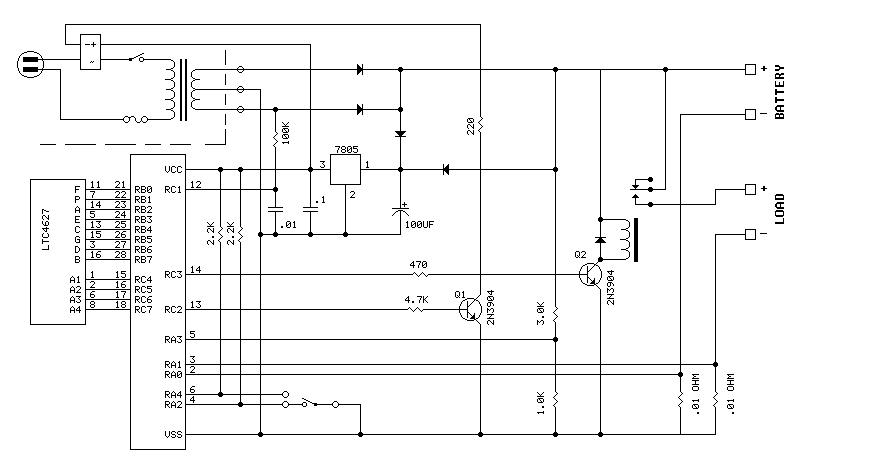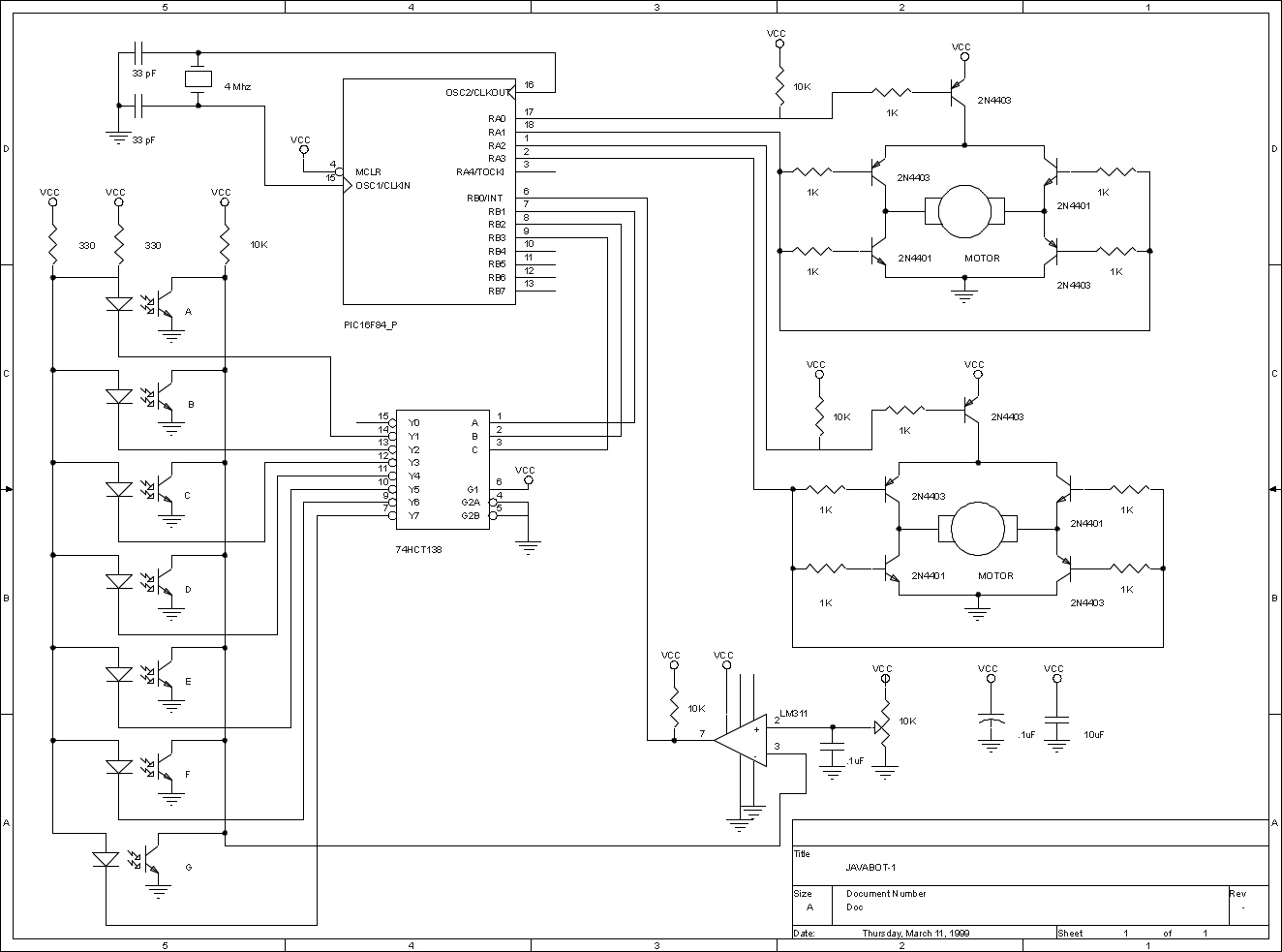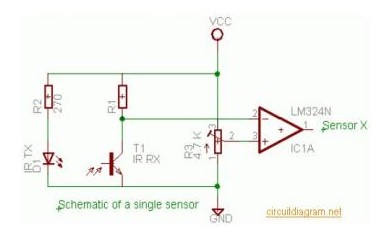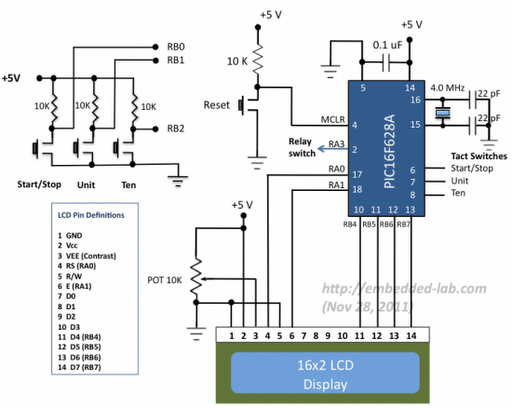
matrix keypad pic microcontroller
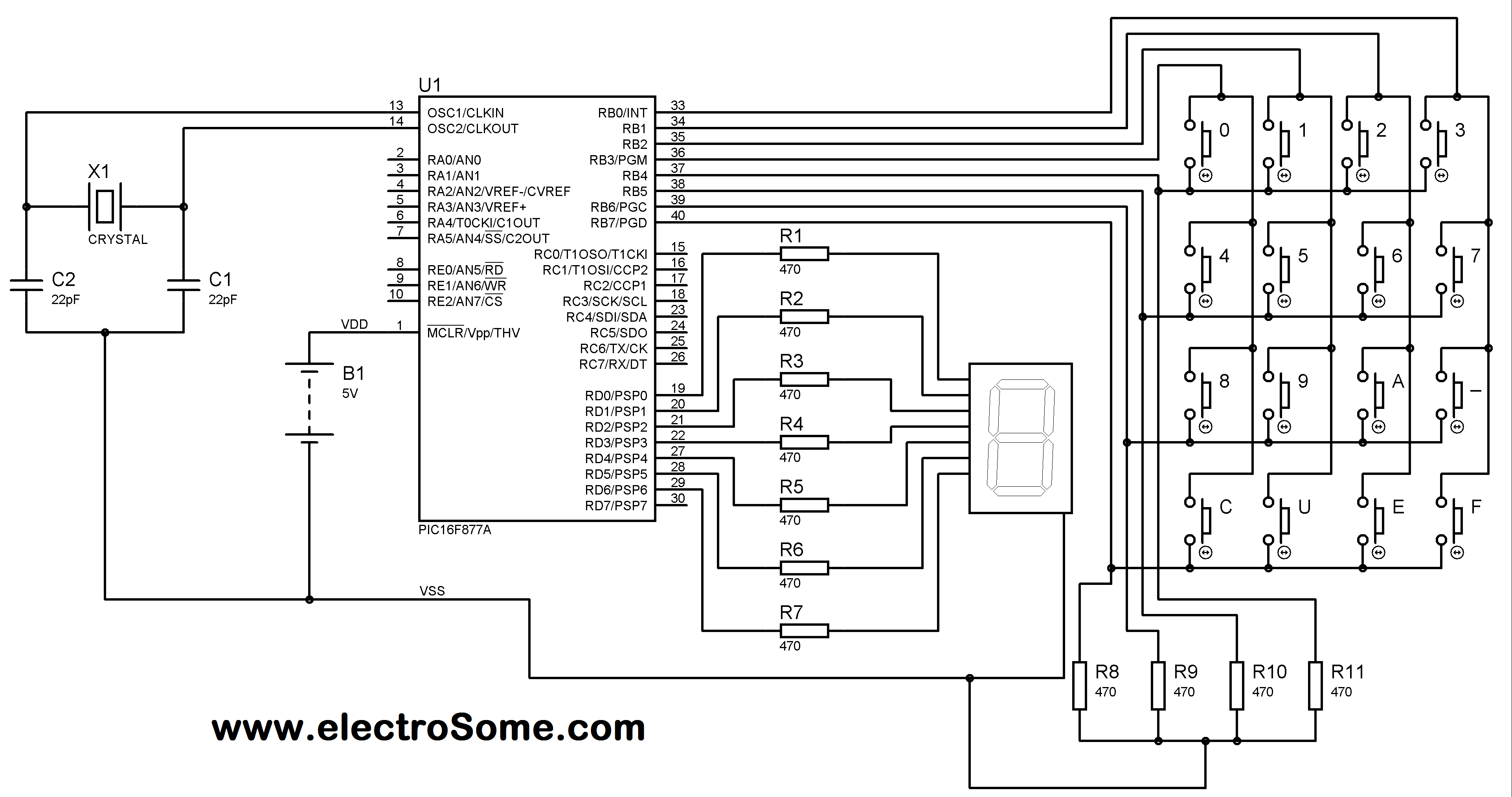
A matrix keypad is a highly useful and user-friendly component in the design of applications such as calculators and telephones. It consists of push-button switches arranged in rows and columns. For instance, interfacing a 4x4 (16 keys) matrix keypad with a microcontroller typically requires 16 pins. However, employing a specific technique allows this to be reduced to 8 pins. The switches in the matrix keypad are connected in a unique configuration. Pressed keys are detected through scanning. For explanation purposes, assume all column connections (Col1 to Col4) function as input pins and all row connections (Row1 to Row4) act as output pins. In a typical scenario (without scanning), all column inputs remain in a LOW (GND) state. During keypad scanning, each row output (Row1 to Row4) is activated sequentially. If a key in the first column is pressed, a logic high signal from Col1 will be transmitted to that row, allowing for key detection. This discussion focuses on detecting one key at a time using a 4x4 matrix keypad, with results displayed on a seven-segment display. Scanning of the matrix keypad stops as soon as a key press is detected and restarts when additional inputs are needed. The matrix keypad connects to PORTB of the PIC microcontroller, with each column connected to RB0 to RB3 (configured as output pins) and each row connected to RB4 to RB7 (configured as input pins). The 4x4 matrix keypad includes characters 0, 1, 2, 3, 4, 5, 6, 7, 8, 9, A, -, C, U, E, and F. The characters B and D are represented as - and U, respectively, due to the seven-segment display used for character representation. For data reading from the matrix keypad, each column is set high, and rows are scanned as previously described. The function readKeyboard() scans the matrix keypad and the function findKey() identifies the pressed key. The function findKey() can be modified to change the character corresponding to each key on the matrix keypad.
The function readKeyboard() initializes the keypad scanning process and returns the character associated with the pressed key when a key press is detected. The scanning mechanism iterates through each row, setting each column high in turn. The state of the input pins is then checked to determine if any key is pressed. The function findKey() is called to map the row and column indices to their respective characters. If no key is pressed, a null character is returned.
The implementation of the findKey() function allows for customization of the characters associated with each key by modifying the return values based on the row and column inputs. This flexibility enables the design to accommodate various applications and user requirements.
Additionally, the seven-segment display integration is managed through the sevenSegmentDecoder() function, which translates the character inputs into the corresponding binary values required to illuminate the correct segments of the display. Each character is mapped to a specific hexadecimal value that represents the segments to be activated. This function can also be modified to include additional characters or change the segment representations as needed.
Overall, the combination of the matrix keypad and the seven-segment display offers a versatile solution for user input in embedded systems, allowing for efficient data entry and visual feedback. The design can be expanded or modified easily to suit a wide range of applications.Matrix Keypad is a very useful and userfriendly when we want to design certain applications like Calculator, Telephone etc. MatrixKeypad is made by arranging push button switches in rows and columns. Just imagine, if you want to interface a 4*4 (16 keys) matrix keypad with a microcontroller. In the straight forward way, you will need 16 pins of a microcontroller for that, but by using a simple technique we can reduce it to 8 pins. In the matrix keypad switches are connected in a special manner a shown in the figure below. Pressed keys can be detected by Scanning. For the sake of explanation, lets assume all column connections (Col1 Col4) are input pins and all row connections (Row1 Row4) are output pins. In the normal case (not scanning) all column inputs where in LOW (GND) state. For scanning keypad, Then each Row output (row1 row4) is scanned one by one. If any of the key belongs to first column is pressed, the Logic high signal from the Col1 will pass to that row.
Through we can detect the key. In this post I am explaining only about detecting one key at a time. For explaining the working I am using a 4*4 matrix keypad and the result is displayed in a Seven Segment Display. Matrix Keypad scanning is stopped as soon as any key press is detected and the Scanning is restarted if we need more inputs.
Matrix Keypad is connected to the PORTB of the PIC Microcontroller. Each column of the Matrix Keypad is connected to RB0 RB3 of the PIC Microcontroller, which are configured as output pins. While each row of the Matrix Keypad is connected to RB4 RB7 of the PIC Microcontroller, which are configured as input pins.
Here I am using 4*4 matrix keypad, having characters 0, 1, 2, 3, 4, 5, 6, 7, 8, 9, A, -, C, U, E, F. B` is replaced by -` and D` is replaced by U` because Seven Segment Display is used for displayingcharacters. B` will besimilarto `8 ² and D` will be similar to `0 ² when displayed in Seven Segment Display. For reading data for the Matrix Keypad, each column is made high and rows are scanned as I said above.
We use the function readKeyboard() to scan the Matrix Keypad and findKey() to find the pressed key. You can edit the function findKey() to change the character corresponds to each key of the Matrix Keypad. char readKeyboard() { unsigned int i = 0; for(i=0;i<4;i+) { if(i = 0) PORTB = 1; else if(i = 1) PORTB = 2; else if(i = 2) PORTB = 4; else if(i = 3) PORTB = 8; if(PORTB. F4) return findKey(i, 0); if(PORTB. F5) return findKey(i, 1); if(PORTB. F6) return findKey(i, 2); if(PORTB. F7) return findKey(i, 3); } return ` `; } This function initiates the keypad scanning and returns the character corresponds to the pressed key when a key press is detected.
It uses the function findKey() to find the character corresponds to a particular row and column. In this function space ( ) is used as the null character, which is returned when no key is pressed, you may change this according to your needs. char findKey(unsigned short a, unsigned short b) { if(b = 0) { if(a = 3) return `0`; else if(a = 2) return `1`; else if(a = 1) return `2`; else if(a = 0) return `3`; } else if(b = 1) { if(a = 3) return `4`; else if(a = 2) return `5`; else if(a = 1) return `6`; else if(a = 0) return `7`; } else if(b = 2) { if(a = 3) return `8`; else if(a = 2) return `9`; else if(a = 1) return `A`; else if(a = 0) return `-`; } else if(b = 3) { if(a = 3) return `C`; else if(a = 2) return `U`; else if(a = 1) return `E`; else if(a = 0) return `F`; } } This function returns the character corresponding to a particular row and column.
You may change characters corresponding to each key according to your need by editing this function. unsigned int sevenSegmentDecoder(char a) { switch(a) { case `0`: return 0x3F; case `1`: return 0x06; case `2`: return 0x5B; case `3`: return 0x4F; case `4`: return 0x66; case `5`: return 0x6D; case `6`: return 0x7D; case `7`: return 0x07; case `8`: return 0x7F; 🔗 External reference
The function readKeyboard() initializes the keypad scanning process and returns the character associated with the pressed key when a key press is detected. The scanning mechanism iterates through each row, setting each column high in turn. The state of the input pins is then checked to determine if any key is pressed. The function findKey() is called to map the row and column indices to their respective characters. If no key is pressed, a null character is returned.
The implementation of the findKey() function allows for customization of the characters associated with each key by modifying the return values based on the row and column inputs. This flexibility enables the design to accommodate various applications and user requirements.
Additionally, the seven-segment display integration is managed through the sevenSegmentDecoder() function, which translates the character inputs into the corresponding binary values required to illuminate the correct segments of the display. Each character is mapped to a specific hexadecimal value that represents the segments to be activated. This function can also be modified to include additional characters or change the segment representations as needed.
Overall, the combination of the matrix keypad and the seven-segment display offers a versatile solution for user input in embedded systems, allowing for efficient data entry and visual feedback. The design can be expanded or modified easily to suit a wide range of applications.Matrix Keypad is a very useful and userfriendly when we want to design certain applications like Calculator, Telephone etc. MatrixKeypad is made by arranging push button switches in rows and columns. Just imagine, if you want to interface a 4*4 (16 keys) matrix keypad with a microcontroller. In the straight forward way, you will need 16 pins of a microcontroller for that, but by using a simple technique we can reduce it to 8 pins. In the matrix keypad switches are connected in a special manner a shown in the figure below. Pressed keys can be detected by Scanning. For the sake of explanation, lets assume all column connections (Col1 Col4) are input pins and all row connections (Row1 Row4) are output pins. In the normal case (not scanning) all column inputs where in LOW (GND) state. For scanning keypad, Then each Row output (row1 row4) is scanned one by one. If any of the key belongs to first column is pressed, the Logic high signal from the Col1 will pass to that row.
Through we can detect the key. In this post I am explaining only about detecting one key at a time. For explaining the working I am using a 4*4 matrix keypad and the result is displayed in a Seven Segment Display. Matrix Keypad scanning is stopped as soon as any key press is detected and the Scanning is restarted if we need more inputs.
Matrix Keypad is connected to the PORTB of the PIC Microcontroller. Each column of the Matrix Keypad is connected to RB0 RB3 of the PIC Microcontroller, which are configured as output pins. While each row of the Matrix Keypad is connected to RB4 RB7 of the PIC Microcontroller, which are configured as input pins.
Here I am using 4*4 matrix keypad, having characters 0, 1, 2, 3, 4, 5, 6, 7, 8, 9, A, -, C, U, E, F. B` is replaced by -` and D` is replaced by U` because Seven Segment Display is used for displayingcharacters. B` will besimilarto `8 ² and D` will be similar to `0 ² when displayed in Seven Segment Display. For reading data for the Matrix Keypad, each column is made high and rows are scanned as I said above.
We use the function readKeyboard() to scan the Matrix Keypad and findKey() to find the pressed key. You can edit the function findKey() to change the character corresponds to each key of the Matrix Keypad. char readKeyboard() { unsigned int i = 0; for(i=0;i<4;i+) { if(i = 0) PORTB = 1; else if(i = 1) PORTB = 2; else if(i = 2) PORTB = 4; else if(i = 3) PORTB = 8; if(PORTB. F4) return findKey(i, 0); if(PORTB. F5) return findKey(i, 1); if(PORTB. F6) return findKey(i, 2); if(PORTB. F7) return findKey(i, 3); } return ` `; } This function initiates the keypad scanning and returns the character corresponds to the pressed key when a key press is detected.
It uses the function findKey() to find the character corresponds to a particular row and column. In this function space ( ) is used as the null character, which is returned when no key is pressed, you may change this according to your needs. char findKey(unsigned short a, unsigned short b) { if(b = 0) { if(a = 3) return `0`; else if(a = 2) return `1`; else if(a = 1) return `2`; else if(a = 0) return `3`; } else if(b = 1) { if(a = 3) return `4`; else if(a = 2) return `5`; else if(a = 1) return `6`; else if(a = 0) return `7`; } else if(b = 2) { if(a = 3) return `8`; else if(a = 2) return `9`; else if(a = 1) return `A`; else if(a = 0) return `-`; } else if(b = 3) { if(a = 3) return `C`; else if(a = 2) return `U`; else if(a = 1) return `E`; else if(a = 0) return `F`; } } This function returns the character corresponding to a particular row and column.
You may change characters corresponding to each key according to your need by editing this function. unsigned int sevenSegmentDecoder(char a) { switch(a) { case `0`: return 0x3F; case `1`: return 0x06; case `2`: return 0x5B; case `3`: return 0x4F; case `4`: return 0x66; case `5`: return 0x6D; case `6`: return 0x7D; case `7`: return 0x07; case `8`: return 0x7F; 🔗 External reference
Warning: include(partials/cookie-banner.php): Failed to open stream: Permission denied in /var/www/html/nextgr/view-circuit.php on line 713
Warning: include(): Failed opening 'partials/cookie-banner.php' for inclusion (include_path='.:/usr/share/php') in /var/www/html/nextgr/view-circuit.php on line 713
